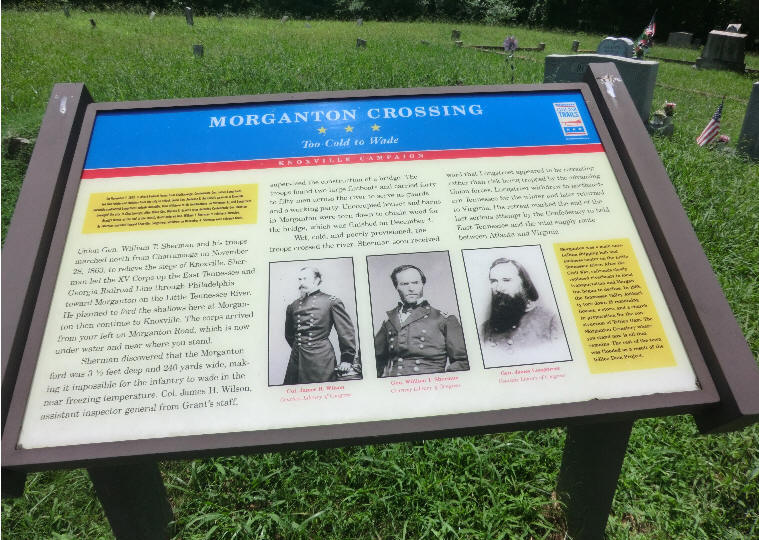MORGANTON UNDERWATER
THE GHOST TOWN OF TELLICO
LAKE
Halfway between Vonore and
Greenback where a modern bridge on a back road connects the two,
lays the sunken ruins of Morganton. At one time during the 19th
century a booming river town that provided ferry service for over
170 years across the Little Tennessee.
A historical marker in the
Morganton Cemetery shows where Union Gen. W.T. Sherman’s troops, on
their way to relieve the siege of Knoxville in December 1863,
constructed a bridge from wood obtained from unoccupied houses and
barns in the town of Morganton to cross the Little Tennessee River.
A Presbyterian church at one time stood nearby.
EARLY HISTORY, 1800-1860
After the American
Revolutionary War, there was increasing pressure by
European-American settlers who started migrating into this area and
squatting on Cherokee lands. The Overhill Cherokees had several
major villages that were located upstream; for instance, Mialoquo
was situated just around Wears Bend, on the opposite side of the
Little Tennessee River. By this time, most of these villages had
either been destroyed in earlier warfare or were in decline, in part
due to high fatalities from smallpox epidemics.
Under pressure from the United
States, the Morganton area was part of the lands ceded by the
Cherokee with the signing of the First Treaty of Tellico in 1798.
The first Euro-American settlers had arrived at the mouth of Bakers
Creek in 1796, however, when the land was still claimed by the
Cherokee. Ethnologist James Mooney recorded a Cherokee legend
regarding blazed trees on the banks "opposite Morganton" that
supposedly marked the location of hidden mines; he first published
it in his volume on myths in 1900.
By 1799 a grist mill had been
established along Bakers Creek by Hugh and Charles Kelso. The
following year, Captain Robert Wear (1781-1846) arrived in the area,
establishing a plantation near the mouth of the river and a ferry
near the mouth of Bakers Creek. In 1801, an inspection port was
established near the ferry, and the small community that developed
in its vicinity became known as "Portville." The name was later
changed to Morganton in honor of Gideon Morgan, who was a
Revolutionary War hero and owned some land up the Little Tennessee
River.
It soon became a bustling
center of commerce when rivers were the chief means of
transportation in the 1800s. Merchants from Maryville and other
towns traveled here to buy goods brought in by boat up the Little
Tennessee River. Being an exchange point for Maryville and Kingston
merchants, helped make the Morganton Road become an important
thoroughfare.
By the 1830s, Morganton had
grown to become the main shipping hub and business center in the
Little Tennessee region. Flatboats carried local products such as
whiskey and hemp to trade throughout the Tennessee Valley — and
sometimes as far away as New Orleans — for products such as
clothing, salt and spices. By 1832, the town had its own doctor,
hatter’s shop, hemp factory, wagon factory, cabinet shop, distillery
and silversmith. A steamboat line connecting Morganton and Knoxville
began operating in 1831
In late 1863, at the height of
the Civil War, Confederate General James Longstreet hoped to cross
the Little Tennessee at Morganton en route from Chattanooga to
Knoxville to dislodge the troops under the command of Ambrose
Burnside, who had occupied Knoxville earlier in the year. Longstreet
later recalled:
Had the means been at hand for
making proper moves I should have marched for the rear of Knoxville
via Morganton and Marysville ...
As Longstreet lacked the
materials to construct a pontoon bridge, however, he was forced to
cross the Tennessee River at Loudon, and approach from the west.
That same year, however, Union General William T. Sherman crossed
the Little Tennessee at Morganton en route to Chattanooga. Sherman
tore down several of the town's houses to construct a pontoon
bridge.
DEATH BY RAILROAD
Morganton was as far up the
river as a steamboat could go since the river became too shallow
further up. Construction of the Louisville and Nashville (L&N)
Railroad lie in 1890 near what is now Greenback was the beginning of
the end for Morganton.
In 1968, the Tennessee Valley
Authority reported 18 houses, a store and a church at Morganton, all
of which were to be torn down in anticipation of the construction of
Tellico Dam. In 1978, University of Tennessee archaeologists
conducted a test survey of the Morganton townsite uncovering several
early American artifacts dating to as early as 1762.
Morganton disappeared under
the waters of Tellico Lake in 1979. Only the cemetery, resting on
the hill overlooking the lake, remains.
FINAL THOUGHT....
There is a legend
attributed to this spot that on early mornings, when the lake is
thick with fog, if you listen very closely, you can hear the sounds
of men pulling the ferry across the water and the whining of horses
on it's deck......
